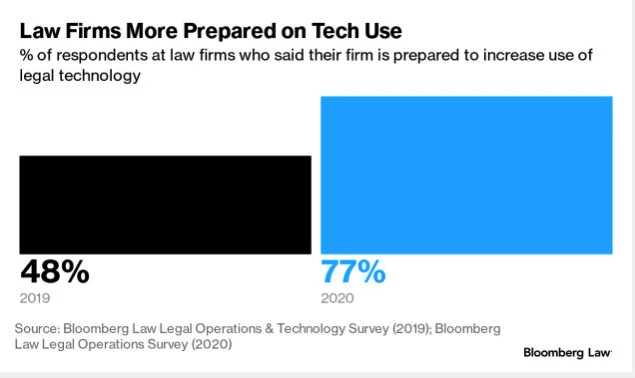As the shift to productizing services and flat fee pricing continues to increase velocity among legal service providers, automating predictable, routine work is no longer just a nice to have. It’s now quickly becoming an imperative for firms, if they are to have any chance of remaining competitive, and even surviving, over the next couple of years.
It’s not real news that the mainstream adoption of automation in the legal industry has been painfully slow. However, given the enormous traction and momentum of the legal technology industry in 2020, it appears this is no longer the case. The need to work remotely was the tushy tap many lawyers needed to get serious about technology and automation.
The more efficient they become, the more enjoyable their work becomes, and the higher margins they make. They are buying more technology than ever before, as they begin to make automating routine tasks a habit.
In fact, 2020 was an unprecedented year for growth at legal tech companies and the growth is only going to continue to accelerate. Gartner is expecting legal tech spending to increase 200% by 2025, over 2020 levels. Here at Woodpecker, we consistently set new usage records every quarter.
If you’re just getting started on your own technology goals, having some knowledge of common technical terms will make learning exponentially easier.
Just as in law, every field has its own specialized language, and the tech industry is far from being an exception. And with dozens of acronyms and complex terms, learning to use software and understanding new technical concepts is much more difficult when you aren’t familiar with the common terminology.
Here are some terms that are helpful for lawyers to know when building an automated workflow for client intake and legal document generation.
API
Application programming interface. Connects two disparate applications so they can share data, eliminating the tedium of wasteful duplicate data entry.
Clause Library
An online library to store frequently used clauses. Clause libraries are a great way to ensure that everyone on your team is using consistent, firm-approved language.
Conditional
Rules that tell a program to execute different actions depending on whether a condition is true or false. For example: if there are multiple people, use the word "people" - if there is just one person, use the word "person".
CRM
Acronym for Customer Relationship Management technology that stores customer data.
Data
Information that has been converted into a form that is efficient for movement or processing.
Database
A large quantity of indexed digital information that can be searched, referenced, compared, or manipulated
DOCX file format
An XML-based file format developed by Microsoft that can contain text, hyperlinks, and other media such as images.
DOTX file format
Template files created by Microsoft Word.
Dynamic data
Data values that are continually updated or changed frequently.
Field
A representation of variable information in a document. For example, your template might have separate fields for Client First Name, Client Last Name, Retainer Amount, and so forth.
Integer
A whole number (example: 1, 2, 3, etc.).
Integration
The ability of the automation software to communicate and work with other programs and technology.
Macro
A macro stands for "macroinstruction" and can be a keyboard shortcut or a small program or script. Macros can save you a lot of time by automating repetitive tasks.
Query
A command that returns specific data from a server.
Parse
The act of analyzing and formatting a specific set of information into a different format. For example, you can take a date format such as 12/1/2021 and parse into a new format such as December 1, 2021.
Static Data
Data values that are not updated or changed frequently.
Template
A file that serves as a starting point for a new document. Details can be added/completed, removed, or modified through the use of variables.
Value
The representation of some entity that can be manipulated by a computer program. A value is usually a number, a single character, or a string of characters (aka words).
Variable
A container used to store dynamic information or values.
Workflow
An orchestrated and consistent pattern of activity (as a series of steps or actions of one or more people) enabled by the systematic organization of resources into processes that evaluate information, deliver documents and services, and transform regulations into actionable advice.


